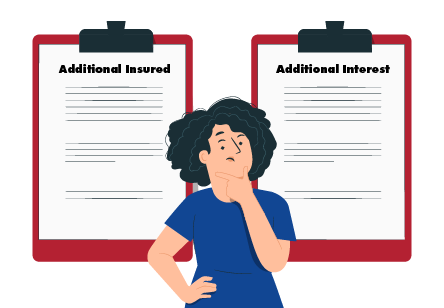With any insurance policy, there will always be a primary policyholder, perhaps it’s you and why you are reading this post.
The primary policyholder is usually the person with their name on and ownership of the insurance policy. They can make any changes they see fit and oversee any claims process.
Primary policyholders are also able to add people referred to as additional insured and additional interest to the policy.
While both sound interchangeable, an additional insured is much more different than an additional interest on an insurance policy.
What is an Additional Interest?
An Additional Interest in auto insurance refers to a third party listed on an insurance policy. It has an interest or stake in the vehicle but is not the primary insured party.
Typically, this could be a lienholder.
Lienholders are usually a financial institution who issued the loan or a lessor in the case of a leased car.
Including an Additional Interest on an auto insurance policy ensures that this individual or company is notified in the event of any changes to the policy, like cancellations or lapses in coverage.
This arrangement protects the financial interests of the Additional Interest, as they may suffer a loss if the vehicle is damaged or destroyed and not adequately insured.
It is important to differentiate that while an Additional Interest is informed about the policy status, they do not receive the insurance benefits directly and are not covered parties in terms of policy claims.
What is an Additional Insured?
An Additional Insured refers to a person or company that is not the primary insured but is added to an insurance policy by the policyholder.
This is a common practice in different types of insurance, including auto insurance.
Additional Insured gives specific coverage under the policy to this third party. This protection is often related to specific risks or activities that would make the asset lose significant value.
For example, in car insurance, a company leasing a vehicle may be listed as an Additional Insured on the lessee’s policy.
This gives them insurance coverage under the policy’s terms. This status differs from being a simple additional interest or loss payee. The Additional Insured gets actual insurance coverage under the policy terms.
The coverage is usually limited to liability coverage from the named insured’s use of the insured vehicle.
Adding an additional insured to an auto insurance policy is a risk management tool for a company. It protects the Additional Insured against certain perils while keeping the policy’s primary beneficiary the named insured.
Additional Insured vs. Additional Interest
The short answer is that what makes additional insured, and additional interest different is that the additional insured would be someone who is added to the policy and is entitled to all the listed coverages.
An additional interest would be someone or a group with financial interests in whatever is insured, a home or a car.
A specific example of an additional insured would be someone living or working with you who is put on the policy because they need the same insurance as you do and qualify for it.
Those living in the same households are typically allowed to be on the same car insurance policy as the car owner since they may use it regularly.
Housemates and roommates can be added as additional insured under a homeowners’ or renters’ policy. Co-workers may also be listed as additional insureds on a work vehicle’s auto policy.
The prime example of an additional interest on an insurance policy would be a car financing company.
This is because they have a financial interest in the car as it’s being paid off. This can also be the case for those who lease commercial property from one such entity.
The additional interest will be in the know whenever damages occur, or a claim is filed.
If your car, which you are currently financing, is totaled, you may be on the line for any remaining payments. Some insurance coverages can insure you against such damages like GAP Insurance.
How Are Additional Insured And Additional Interest Listed in an Insurance Policy?
Let’s look into how an additional insured or an additional interest will appear on a car insurance policy.
As previously mentioned, cars under a finance plan or lease usually require an additional interest because the company providing the vehicle is the owner until the loan on the car is fully paid off.
These lending and finance companies will often require drivers of their cars to have full coverage car insurance for the exact reason we just went over. The vehicle gets totaled in an accident and needs to be fully paid off.
An insurance agent from your car insurance company will always be in contact with the leasing company until the loan is paid off fully.
The most common reason an additional interest may appear on any property or residents’ insurance is a mortgage. The lending company or party would be listed on the homeowners’ policy until it’s paid off.
An additional insured may be listed on a homeowners’ policy if a housemate or other property owner is a co-signer on said mortgage. They could also file claims if the primary policyholder isn’t present.
Other living spaces like condos and apartments have insurance policies similar to homeowners. A condo can also have a mortgage or a lender attached as an additional interest like a home would, with anyone living there as a co-signer or resident being listed on the policy as additional insured.
Renters’ insurance is more orientated for property and assets protection since the landlord is the party that owns the space.
Some landlords request to be listed as an additional interest on a renters insurance policy as the property owner. Again, any roommate or co-signer on the lease agreement should also be an insured party.
Why are Additional Insured and Additional Interest Important?
Having additional insureds and additional interests for any insurance policy is all about maximizing protection and extending it to anyone else who may need it.
It may also be a requirement from those with actual ownership or insurance companies.
Understanding and applying Additional Insured and Additional Interest in auto insurance policies is necessary for thorough risk assessment and management.
These roles help identify the coverage and liabilities among the involved parties. This can prevent potential legal disputes and financial losses.
It’s always a good idea to extend something as liability coverage or property damage to someone who frequents or owns your car or home.
Frequently Asked Questions
Who needs to be added as an additional insured?
Landlords, clients, general contractors, property owners and other parties who could be held liable for your actions want to be added as additional insureds on your liability insurance policy.
Who usually gets added as an additional interest?
Lenders, lienholders, mortgage companies and sometimes landlords are added as additional interests to be notified of the status of the insurance policy that protects their interest.
Can an additional interest file an insurance claim?
No, an additional interest cannot file a claim or receive claim payments. They only get notified of cancellations, non renewals or major changes to the insurance policy.
Can an additional insured file an insurance claim?
Yes, an additional insured can be defended by the insurer and receive claim payments if they are sued or held liable for a covered loss under the insurance policy.
Can someone be both an additional insured and an additional interest at the same time?
In most cases yes, but insurers usually classify them as an additional insured if they require coverage, since that already implies they have an interest in the risk.




